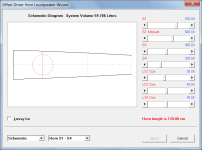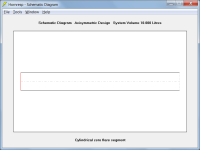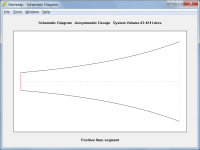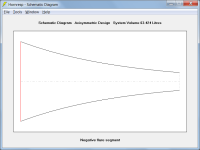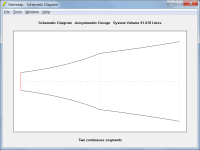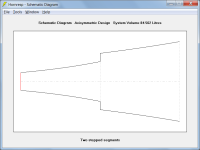I wouldn't lose too much sleep over the round vs square cross section, especially with a modicum of damping material in the box.
I'm not sure it's that simple. If you analyse using the equivalent plane wave in a constant width tube, this takes the pipe width out of the equation, and hence it's shape.it's my understanding that historically HR only uses CSA of circular pipes,
Carrying on,
I redrew the cab as BR in box modelling. This was to get rid of the throat adaptor so that I may attach Hornresp files as recommended earlier in the thread. I don't really know if I should stick to the taller cab, as the 3.5" FR drivers really sound amazing on a very narrow baffle and with a dish fitted over the cone that masks everything but the cone and roll surround. I have worked out the best sounding taper and height for this dish by listening for the best spread around the listening room, which is being used to lay out the interior of the 20' houseboat that we are building slowly in semi retirement as funds and time permit. The trailer and highly modelled cat hulls are done. The hulls will plane safely with twin 60s and cruise frugally on electric when not up on plane
For this BR, I dropped the tuning to 23hz as per recommendation to see if a bit of eq can get this flat to 20hz. Doesn't need to be loud, it's for nighttime movies. I haven't run Hornresp sims yet, but Winisd shows flat to 20 with eq
We know it can be modelled in HR as either, with the same results, apparently. The shape of the box is constrained by the space on the counter where it will go. Pipe resonance will be a challenge and a PR may be the solution
The original question is without answer, though, is this one here now a BR or TL?

I redrew the cab as BR in box modelling. This was to get rid of the throat adaptor so that I may attach Hornresp files as recommended earlier in the thread. I don't really know if I should stick to the taller cab, as the 3.5" FR drivers really sound amazing on a very narrow baffle and with a dish fitted over the cone that masks everything but the cone and roll surround. I have worked out the best sounding taper and height for this dish by listening for the best spread around the listening room, which is being used to lay out the interior of the 20' houseboat that we are building slowly in semi retirement as funds and time permit. The trailer and highly modelled cat hulls are done. The hulls will plane safely with twin 60s and cruise frugally on electric when not up on plane
For this BR, I dropped the tuning to 23hz as per recommendation to see if a bit of eq can get this flat to 20hz. Doesn't need to be loud, it's for nighttime movies. I haven't run Hornresp sims yet, but Winisd shows flat to 20 with eq
We know it can be modelled in HR as either, with the same results, apparently. The shape of the box is constrained by the space on the counter where it will go. Pipe resonance will be a challenge and a PR may be the solution
The original question is without answer, though, is this one here now a BR or TL?
Absolutely not the intent. It's a tall order to master acoustical modeling in a day, and answers are a little thinner here for those expressing commercial intent for the projects. Thought this thread already had every clue necessary and then some. Credit to you for being up-front with your intent....
I realise that I have been made sport off and take it in good spirits, but do wish you guys had pointed out to change that setting. All is well, armed with that, I can try to make cabs that work like the sims
...
Learned something from you! 👍 I'm way behind in all the advanced features, my HR input knowledge stalled out back at the multiple entry horns (MEH).To date, I couldn't insert a different value for SD at the step, as the last S* in one row wants to be the same as the first S* in the next row in Hornresp and my previous queries re this didn't attract any input.
I realise that I have been made sport off and take it in good spirits, but do wish you guys had pointed out to change that setting.
Sorry man, I think you misunderstood my last query.
Yeah, many over time over the various audio forums have left me in the 'dust' to the point of banning me in some cases till I learned enough to convert what I either have observed or intuited into at least some semblance of techno speak.
Yeah, wasn't really following, so 'took a shot' in the hope of someone cluing me in (thanks AlanB 👍)
Sticking with my original opinion. 😉The original question is without answer, though, is this one here now a BR or TL?
Not the intention. When I advised you to ask on the hornresp thread, I did it knowing that hornresp has a unique interface. It's a unique programme. I can tell you you're not alone 😉I realise that I have been made sport off and take it in good spirits,
I have never tried to hide the fact I am trying to set up a little cottage business making bass amps and similar. To support a working retirement and being a full time cater of an infant. I have neither the means nor the interest to get rich with this. I am attracted by the prestige gained by being a maker of things. The sound bar that I would like to make and sell is for musical instruments. Bass sings a lot higher and you’ll see that my instrument amps are tuned over 40z. I came across a promising driver for a baby amp and thot try it for personal home theatre as it came with that recommendation
If this HT sound bar works well, I think there might be folks around who might want similar and it would be a pleasure to make a few more
Previously in another life, I made a career out of handiwork and was reviewed in Australian magazines ad well as international. Unfortunately the industry went from recreation to bloodsport and I bowed out as my conscious wouldn’t allow me to continue. Now with my focus on family and our home studio, these cabs are for smoke money
If this HT sound bar works well, I think there might be folks around who might want similar and it would be a pleasure to make a few more
Previously in another life, I made a career out of handiwork and was reviewed in Australian magazines ad well as international. Unfortunately the industry went from recreation to bloodsport and I bowed out as my conscious wouldn’t allow me to continue. Now with my focus on family and our home studio, these cabs are for smoke money
Thanks for always speaking clearly man. Discussing this has helped solved "un beknownst to me but beknownst to everyone else" issue. Helps me finally reconcile my universal CAD template for the adjustable TL in structural foam, too. A quieter, undersize port has also fired up my imagination. I am good with fluids and I think I have something, but it will take someone who knows what they are doing to test thatLearned something from you! 👍 I'm way behind in all the advanced features, my HR input knowledge stalled out back at the multiple entry horns (MEH).
Yeah, many over time over the various audio forums have left me in the 'dust' to the point of banning me in some cases till I learned enough to convert what I either have observed or intuited into at least some semblance of techno speak.
Yeah, wasn't really following, so 'took a shot' in the hope of someone cluing me in (thanks AlanB 👍)
As always, it is also a pleasure for me to share my wins back. If this 1m long speaker is worth building, I'll do it in structural foam too and attach the file here. Now I am stuck at whether to keep the throat adaptor for the BR too to keep the baffle at the FR drivers narrow or go 143mm internal tall all the way as in the most recent box plan pic. I can round off the baffle at the ends of the cab so that the FR drivers appear to be sitting on eggshells and wearing my little dishes as an overlay
Allen, thanks man. I wanted to ask on that thread but seen folks get told to go away and start another with their queries. I haven't had the fortune of any feedback in previous queries re this. Hornresp interface is what it needs to be, I see it as an internal spreadsheet controlled by forms type of thing, and for that it's plentyNot the intention. When I advised you to ask on the hornresp thread, I did it knowing that hornresp has a unique interface. It's a unique programme. I can tell you you're not alone 😉
What I find missing is ctrl+paste. Right-clicking and copying from FreeCAD is intuitive as that is a first person view environment. But filling a form needs keyboard shortcuts...........so that the process of lathering and rinsing over a million iterations that Grindstone spoke about is easier
Btw, if you don't mind, where about do you fall down under? I am in Hervey Bay, QLD........ And you too Stuey if you are reading this
so that the process of lathering and rinsing over a million iterations that Grindstone spoke about is easier
Have you tried using the Loudspeaker Wizard tool?
Attachments
Re pipe resonances
This is for the educated types, could another industry have solved pipe resonances but not applied it to speaker ports? Hydraulics maybe, pump noise might propagate through the pipes types of things? Jet noise in a duct? Has a knowing type of speaker enthusiast already looked in this areas for a solution? I would, but no point until I have a good handle on what the sound is doing inside the pipes
Port chuffing though is an airspeed issue and I think that has already been taken care of by propellers. I can't do engineering on this, but can try to replicate some of those ideas in trial and error
This is for the educated types, could another industry have solved pipe resonances but not applied it to speaker ports? Hydraulics maybe, pump noise might propagate through the pipes types of things? Jet noise in a duct? Has a knowing type of speaker enthusiast already looked in this areas for a solution? I would, but no point until I have a good handle on what the sound is doing inside the pipes
Port chuffing though is an airspeed issue and I think that has already been taken care of by propellers. I can't do engineering on this, but can try to replicate some of those ideas in trial and error
3 segment pipe = 6 faces =
Needs data in S1 to S4 = 4 faces
Hornresp assumes continuous segments by default. For a three segment system this means:
S1 = Segment 1 throat area
S2 = Segment 1 mouth area and Segment 2 throat area
S3 = Segment 2 mouth area and Segment 3 throat area
S4 = Segment 3 mouth area
Attachment 1 in my previous post refers.
As you have found, it is possible for the user to specify stepped segments. For a three segment system this means:
S1 = Segment 1 throat area
S2 = Segment 1 mouth area
S2S = Segment 2 throat area
S3 = Segment 2 mouth area
S3S = Segment 3 throat area
S4 = Segment 3 mouth area
Attachment 4 in my previous post refers.
Attachment 1 below shows a cylindrical zero flare segment
Attachment 2 below shows a positive flare segment
Attachment 3 below shows a negative flare segment
Attachment 4 below shows a tapered segment
Attachment 5 below shows two continuous segments
Attachment 6 below shows two stepped segments
Attachments
David, I opened it and closed it. I didn't know what all the sliders did and what the drop-down menu set at the bottom did. I can't even find where to change the signal power like in Winisd to see what the excursion did at a lot higher power. It's been suggested to me that the driver is good for over 600w with music and that it is very DSP friendly in a very tiny ported boxes. I can sim the eq and power in Winisd thoughHave you tried using the Loudspeaker Wizard tool?
Btw, if you don't mind, where about do you fall down under? I am in Hervey Bay, QLD........ And you too Stuey if you are reading this
Randy, I'm sure no one was making sport of you. I'm certainly not qualified to do that - I'm yet to use Hornresp in any case. I must have a crack at it.
If by the above you mean where are we. I'm in Perth. If you hover over the flag next to the name it pops up.
Hey man, really appreciate that you took the time to detail that and confirm. Do you have any tips for modelling the acoustics for port flares? Do you feel simming for a good skin friction and minimising fluid separation and tip vortices would have any adverse effects on the sound around the port frequencies? This is a question about building for airspeed performance to minimise chuffing as it looks like I can't fit a substantial port in the available spaceHornresp assumes continuous segments by default. For a three segment system this means:
S1 = Segment 1 throat area
S2 = Segment 1 mouth area and Segment 2 throat area
S3 = Segment 2 mouth area and Segment 3 throat area
S4 = Segment 3 mouth area
Attachment 1 in my previous post refers.
As you have found, it is possible for the user to specify stepped segments. For a three segment system this means:
S1 = Segment 1 throat area
S2 = Segment 1 mouth area
S2S = Segment 2 throat area
S3 = Segment 2 mouth area
S3S = Segment 3 throat area
S4 = Segment 3 mouth area
Attachment 4 in my previous post refers.
Attachment 1 below shows a cylindrical zero flare segment
Attachment 2 below shows a positive flare segment
Attachment 3 below shows a negative flare segment
Attachment 4 below shows a tapered segment
Attachment 5 below shows two continuous segments
Attachment 6 below shows two stepped segments
Do you have any tips for modelling the acoustics for port flares?
If by port flares you mean a cylindrical port tube with flared ends, then no.
Do you feel simming for a good skin friction and minimising fluid separation and tip vortices would have any adverse effects on the sound around the port frequencies?
Not sure what you mean. If anything, I would have thought that such measures would have a positive, rather than a negative, effect.
Either way, it is not something that Hornresp is capable of doing.
David, I opened it and closed it.
I strongly recommend that you open it again and just experiment. The Loudspeaker Wizard is a very powerful and useful tool.
I didn't know what all the sliders did and what the drop-down menu set at the bottom did.
Which sliders don't you understand?
As far as the drop-down lists are concerned, the one on the left selects the output chart or schematic diagram to display, and the one alongside it selects the input parameter sliders to display.
I can't even find where to change the signal power like in Winisd to see what the excursion did at a lot higher power.
To increase the power simply increase the value of the Eg slider. The default value is 2.38 volts which represents 1 watt into an 8 ohm load.
It's been suggested to me that the driver is good for over 600w with music
Setting Eg to 70 volts will give you 612.5 watts into 8 ohms.
I can sim the eq and power in Winisd though
Equalisation can be applied if required, and absorbent filling material can be added.
See the Hornresp Help file for further details.
I think the effect can be in dialled either way. There are a few things that I can try and see as I think the answer to port chuffing is not flares but a properly designed nozzle pair for either ends of the port. The whole port should have a lengthwise cross-section resembling a proa waterline with a roll-over on the nozzle end that goes back to the baffle surface and removes all fluid separating cleanly on any point. Is that not the only thing that can create a chuff?Not sure what you mean. If anything, I would have thought that such measures would have a positive, rather than a negative, effect
Thanks again. I thought the help file might be incomplete, it stops at "phase response". That's why I couldn't find much help in it. But my bad, for some reason the mouse wheel won't scroll it. It made me think that was all available. I can see now the scroll bar works though and can see more on that list so will have a good look through thatSee the Hornresp Help file for further details.
- Home
- Loudspeakers
- Subwoofers
- Is it a bass reflex or TL?
